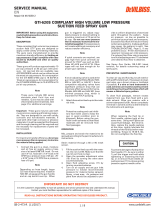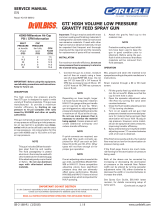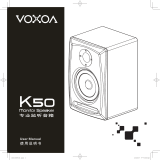Page is loading ...

E
E
P 2 - 11
D
D
P 22 - 31
F
F
P 12 - 21
SB-E2-2-531
Operation Manual
Advanced Conventional Pressure Feed Spraygun
ISS.02

© 2003 ITW Finishing Systems and Products
2
Operation Manual
Advanced Conventional
Pressure Feed Spraygun
Important
Read and follow all instructions and Safety Precautions before using this
equipment
Description
The Compact pressure feed Spraygun Kit is complies to ATEX regulations 94/9/EC, protection level;
II 2 G X, Suitable for use in Zones 1 and 2
Important: These Sprayguns are suitable for use with solvent based materials. These guns are
not designed for use with highly corrosive and/or abrasive materials and if used with such materials it
must be expected that the need for cleaning and/or replacement of parts will be increased. If there is
any doubt regarding the suitability of a specific material contact your local Distributor or ITW Finishing
direct.
E
E
Model Part Number
Example: COM-P430-14
Aircap Fluid nozzle size
(14 = 1,4 mm)
ITW Finishing Systems and Products reserve the right to modify equipment specification with-
out prior notice.
EC Declaration of Conformity
We: ITW Finishing UK, Ringwood Rd, Bournemouth, Dorset, BH11 9LH, UK, as the
manufacturer of the Spraygun model Compact, declare, under our sole responsibility, that the
equipment to which this document relates is in conformity with the following standards or other
normative documents:
BS EN 292-1 PARTS 1 & 2: 1991, BS EN 1953: 1999; and thereby conform to the
protection requirements of Council Directive 98/37/EC relating to Machinery Safety Directive,
and;
EN 13463-1:2001, council Directive 94/9/EC relating to Equipment and Protective
Systems intended for use in Potentially Explosive Atmospheres protection level II 2 G X.
B. Holt, General Manager
30th June 2003

© 2003 ITW Finishing Systems and Products
3
SAFETY WARNINGS
Fire and explosion
Solvents and coating materials
can be highly flammable or
combustible when sprayed. ALWAYS
refer to the coating material suppliers
instructions and COSHH sheets
before using this equipment
Users must comply with all local
and national codes of practice
and insurance company
requirements governing
ventilation, fire precautions, operation
and house-keeping of working areas
This equipment, as supplied,
is NOT
suitable for use with
Halogenated Hydrocarbons
.
Static Electricity can be
generated by fluid and/or air
passing through hoses, by the
spraying process and by cleaning non-
conductive parts with cloths. To prevent
ignition sources from static discharges,
earth continuity must be maintained to
the spraygun and other metallic
equipment used. It is essential to use
conductive air and/or fluid hoses.
Personal Protective
Equipment
Toxic vapours – When sprayed,
certain materials may be
poisonous, create irritation or be
otherwise harmful to health.
Always read all labels and safety data
sheets for the material before spraying
and follow any recommendations. If In
Doubt, Contact Your Material Supplier
The use of respiratory protective
equipment is recommended at all
times. The type of equipment
must be compatible with the material
being sprayed.
Always wear eye protection when
spraying or cleaning the spraygun
Gloves must be worn when
spraying or cleaning the
equipment
Training – Personnel should be given
adequate training in the safe use of
spraying equipment.
Misuse
Never aim a spraygun at any part of the
body
Never exceed the max. recommended
safe working pressure for the equipment
The fitting of non-recommended or non-
original spares may create hazards
Before cleaning or maintenance, all
pressure must be isolated and relieved
from the equipment
The product should be cleaned using a
gun washing machine. However, this
equipment should not be left inside gun
washing machines for prolonged periods
of time.
Noise Levels
The A-weighted sound level of
sprayguns may exceed 85 dB
(A) depending on the set-up
being used. Details of actual noise levels
are available on request. It is
recommended that ear protection is worn
at all times when spraying.
Operating
Spray Equipment using high pressures
may be subject to recoil forces. Under
certain circumstances, such forces could
result in repetitive strain injury to the
operator.
E
E

© 2003 ITW Finishing Systems and Products
4
Parts List
Ref. No Description Part Number Qty Options
1 Air Cap/Retaining ring
COM-430 or COM-497
SP-100-***-K 1 430, 497
e.g *** = 430
+ 2 Nozzle SP-200S-**-K 1 085,10,11,12,13,14,
16,18,20,22
e.g ** =14 =1.4mm
+ 3 Separator SP-623-K5 5
+ 4 Packing GTI-445-K2 2
5 Spreader Valve SP-401-K 1
6 Stud and Screw GTI-408-K5 5
7 Needle Adjusting Screw SP-614-K 1
+ 8 Spring SP-622-K5 1
+
Needle SP-300S-**-K 1 085,10,11,12,13,14,
16,18,20,22
e.g ** =14 =1.4mm
Needle—Plastic tipped SP-300P-**-K 10, 12, 14
e.g ** =14 =1.4mm
10 Airvalve housing + seal SP-612-K 1
+ 11 Spindle 1
12 Trigger SP-617-K 1
13 Connector SP-611-K 1
14 Airflow Valve SP-402-K 1
15 Fluid Inlet Connector and seal SP-610–K 1
+ 16 Air Valve Service Kit SPK-101-K 1
17 RetainingRing and Seals SPK-102-K 1
+ 18 Spreader/ Cheater Service Kit GTI-428-K5 5
19 Circlip 25746-007-K5 5
+ 20 Air valve Assembly Tool 1
21 Spanner SPN-5 1
Spraygun Service Kit
(parts included marked + )
SPK-401-** 1 085,10,11,12,13,14,
16,18,20,22
e.g ** =14 =1.4mm
9
E
E

© 2003 ITW Finishing Systems and Products
5
Specification
E
E
Patent No 2372465 (GB)
Air supply connection - Universal
1
/
4
“ BSP and NPS
Fluid Supply Connection - Universal
3
/
8
“ BSP and NPS
Maximum static Air inlet pressure - P
1
= 12 bar (175 psi)
Maximum static Fluid inlet pressure - P
2
= 15 bar (218 psi)
Nominal gun Air inlet pressure -
with gun triggered
3.0 bar (44 psi)
Maximum Service temperature 40°C
Gun Weight - 435 g
Materials of Construction
Gun body Aluminium
Nozzle Stainless Steel
Needle Stainless Steel
Fluid Inlet Stainless Steel / PTFE
Trigger Nickel Plated Steel

© 2003 ITW Finishing Systems and Products
6
Installation
Important: To ensure that this equipment
reaches you in first class condition,
protective coatings have been used.
Flush the equipment through with a
suitable solvent before use.
1. Attach air hose to connector (13).
Recommended hose size 8 mm
bore. The hose must be conductive
and electrical bond from the
spraygun to earth should be checked
with an ohmeter. A resistance of less
than 10
6
Ohms is recommended.
2 Attach fluid supply hose to Fluid
Inlet (15).
1. Turn off air and coating supply and
relieve pressure in the supply lines,
or if using QD system, disconnect
from airline and fluid line.
2. Remove air cap (1) and clean. If any
of the holes in the cap are blocked
with coating material use a toothpick
to clean. Never use metal wire which
could damage the cap and produce
distorted spray patterns
3. Ensure the tip of the nozzle (2) is
clean and free from damage. Build
up of dried paint can distort the spray
pattern.
4. Lubrication – stud/screw (6), needle
(9) and air valve (11) should be oiled
each day.
Preventative Maintenance
E
E
Operation
1. Mix coating material to manufacturers
instructions
2. Turn needle adjusting screw (7)
clockwise to prevent movement.
3. Turn spreader valve (5) counter-
clockwise to fully open.
4. Adjust inlet air pressure to give 3 bar
(44 psi) at the gun inlet with the gun
triggered. (pressure gauge
attachment shown under Accessories
is recommended for this).
5. Turn needle adjusting screw counter
clockwise until first thread shows.
6. Test spray. If the finish is too dry
reduce airflow by reducing air inlet
pressure or by the Airflow Valve (14).
Screw the Adjusting Knob (14) in to
reduce pressure.
7. If finish is too wet reduce fluid flow by
turning needle screw (7) clockwise or
reducing the fluid pressure. If
atomisation is too coarse, increase
inlet air pressure. If too fine reduce
inlet pressure.
8. The pattern size can be reduced by
turning adjusting valve (5) clockwise.
9. Hold gun perpendicular to surface
being sprayed. Arcing or tilting may
result in uneven coating.
10. The recommended spray distance is
150-200 mm (6”-8”).
11. Spray edges first. Overlap each
stroke a minimum of 50%. Move gun
at a constant speed.
12. Always turn off air and fluid supply
and relieve pressure when gun is not
in use.

© 2003 ITW Finishing Systems and Products
7
Replacement of Parts
Nozzle (2) and Needle (9) – Remove
parts in the following order: 7, 8, 9, 1 and
2. Replace any worn or damaged parts
and re-assemble in reverse order.
Recommended tightening torque for
nozzle (2) 9.5-12 Nm (80-100 lbf in).
Packing – Remove parts 7, 8, 9.
Unscrew cartridge (4). Fit new cartridge
finger tight. Re-assemble parts 9, 8, and
7 and tighten cartridge (4) with spanner
sufficient to seal but to allow free
movement of needle. Lubricate with gun
oil.
Air Valve Seal Kit (16) - (Refer to
photos 1 to 28 and fig 2).
1. Remove Adjusting Knob (7), Spring
(8), and Needle (9).
2. Loosen Housing (10).
3. Remove Housing (10) and Airvalve
Spring.
4. Remove Valve (11).
5. Using Service Tool SPN-7, engage
groove behind the Valve Seat.
6. Remove Valve Seat.
7. Push out the Front Airvalve Seal with
a finger.
8. Turn the Gun upside down and let the
Seal fall out.
9. Fit New Front Seal to Service Tool.
10. Fit new Seal to gunbody and press
firmly to ensure Seal is engaged.
11. Fit New Valve Seat to Service Tool.
Groove must face outwards.
12. Fit Valve Seat to Gunbody.
13. Remove Rear Airvalve Seal from
housing (10) with a hooked
instrument.
14. Fit new Seal to Service Tool.
15. Fit Seal to Housing (10).
16. Replace Valve (11).
17. Replace Valve Spring and screw in
Housing (10).
18. Tighten Housing.
19. Fit Needle (9).
20. Fit Spring (8) and Knob (7).
21. Adjust Needle Packing (4) with
Spanner sufficient to seal but to allow
free movement of needle. Lubricate
with gun oil.
Spreader valve (5) – Caution: always
ensure that the valve is in the fully open
position by turning screw fully counter-
clockwise before fitting to body.
Air cap / Nozzle Selection
Refer to coating material manufacturers
recommendations or ITW Finishing UK
Website:
www.itweuropeanfinishing.com
FIG 2

© 2003 ITW Finishing Systems and Products
8
1 2
3 4
5 6
7 8

© 2003 ITW Finishing Systems and Products
9
9 10
11
11a
12
13
14
15

© 2003 ITW Finishing Systems and Products
10
Accessories
Spanner – order SPN-5
Cleaning Brush – order 4900-5-1-K3
Regulator/Gauge Attachment - order HAV-501-B
Pressure gauge Attachment – order GA-515
Gun Mounted Regulator – order DVR-501
Spraygun Lubricant - order GL-1-K10
17
18
19
20
21
16

© 2003 ITW Finishing Systems and Products
11

© 2003 ITW Finishing Systems and Products
15
Spécifications
F
F
Brevet N° 2372465(GB)
Raccord d’alimentation d’air - Universel
1
/
4
“ BSP and NPS
Raccord d'alimentation de produit - Universel
3
/
8
“ BSP and NPS
Pression d’entrée statique d'air maximale - P
1
= 12 bar (175 psi)
Pression d’entrée statique de liquide maximale - P
2
= 15 bar (218 psi)
Pression d’entrée d’air nominale de pistolet –
actionnée
3.0 bar (44 psi)
Température de service maximale - 40°C
Poids du pistolet - 435 g
Matières de construction
Corps du pistolet Aluminium
Buse Acier inoxydable
Aiguille Acier inoxydable
Entrée de produit Acier inoxydable / PTFE
Gâchette Acier nickelé

© 2003 ITW Finishing Systems and Products
18
1 2
3 4
5 6
7 8

© 2003 ITW Finishing Systems and Products
19
9 10
11
11a
12
13
14
15

© 2003 ITW Finishing Systems and Products
21

© 2003 ITW Finishing Systems and Products
28
1 2
3 4
5 6
7 8

© 2003 ITW Finishing Systems and Products
29
9 10
11
11a
12
13
14
15

© 2003 ITW Finishing Systems and Products
31

© 2003 ITW Finishing Systems and Products
32
ITW Finishing Systems and Products
Ringwood Road,
Bournemouth,
BH11 9LH,
England.
Tel. No. (01202) 571111
Telefax No. (01202) 581940,
Website address http://www.itweuropeanfinishing.com
ITW Oberflächentechnik GmbH & Co. KG
Justus-von-Liebig-Straße 31
63128 Dietzenbach
Telefon: (06074) 403-1
Telefax: (06074) 403-300
Internet: http://www.itw-finishing.de
ITW Surfaces et Finitions
163-171 avenue des Auréats B.P. 1453
26014 VALENCE CEDEX FRANCE
Tél. (33) 475-75-27-00
Télex 345 719F DVILBIS
Téléfax: (33) 475-75-27-99
ITW Finishing Systems and Products is a Division of ITW Ltd. Reg. Office:
Admiral House,
St Leonard’s Road,
Windsor,
Berkshire,
SL4 3BL,
UK
Registered in England: No 559693 Vat No 619 5461 24
Nov 05
/









